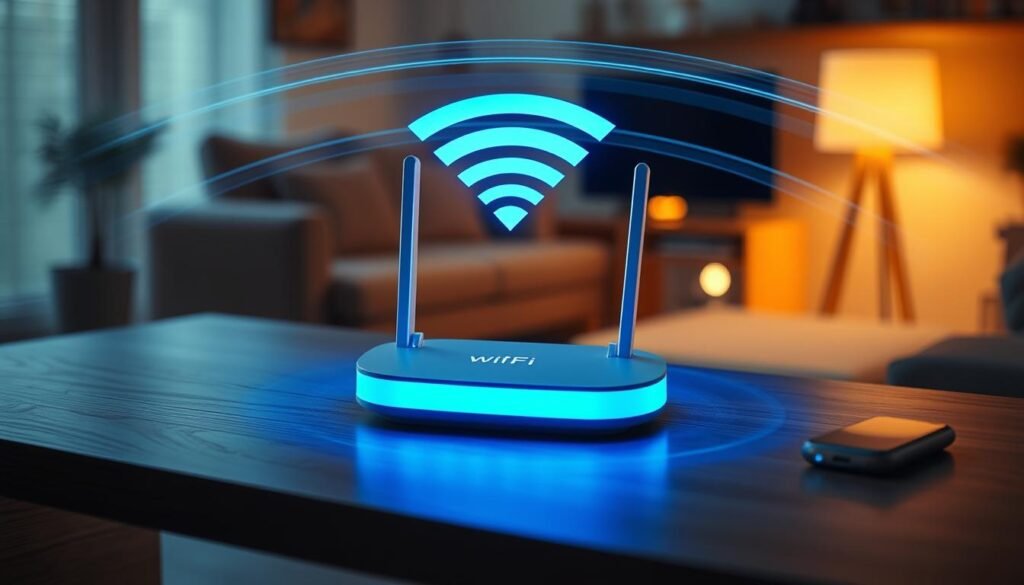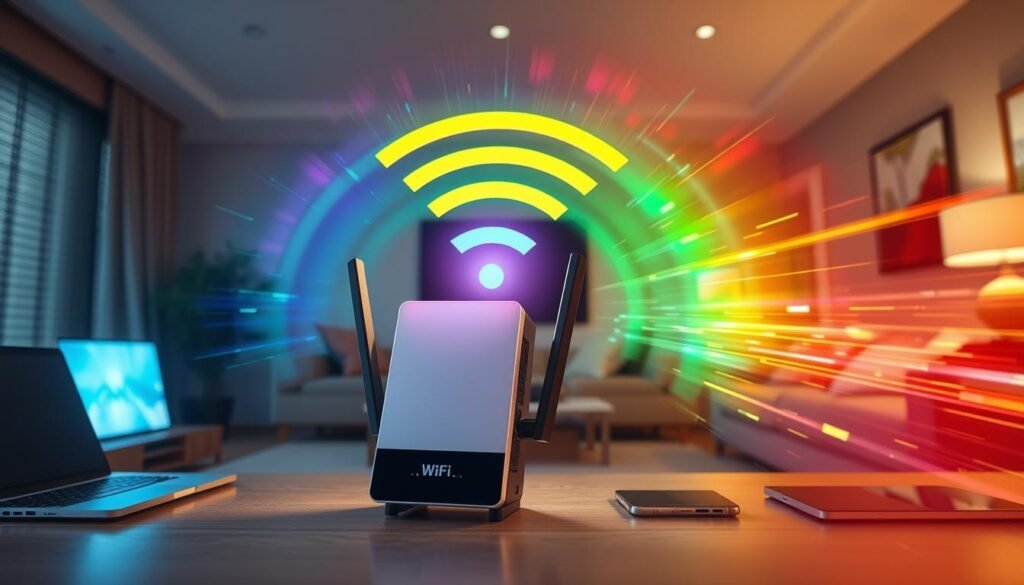How to Improve Your Wi-Fi Signal Strength
In today’s world, a strong Wi-Fi signal is key for smooth internet use at home. It’s vital for streaming, video calls, and web browsing. Luckily, there are ways to boost your Wi-Fi and get rid of dead zones.

Key Takeaways
- Understand the factors that can impact your Wi-Fi signal strength, such as distance, obstacles, and interference.
- Explore strategic placement of your router to optimize wireless coverage throughout your home.
- Investigate the use of Wi-Fi signal boosters or range extenders to amplify your network’s reach.
- Ensure your router is configured correctly and running the latest firmware updates.
- Minimize interference from other wireless devices and household appliances.
By using the tips in this article, you’ll get a faster, more reliable Wi-Fi connection. Say goodbye to connectivity problems and hello to smooth internet access everywhere in your home.
Understanding Wi-Fi Signal Strength
Having a strong Wi-Fi signal is key for smooth internet use at home or work. The signal’s strength depends on several things. These include how far you are from the router, any physical barriers, and interference from other devices.
Factors Affecting Signal Quality
Several factors can impact your Wi-Fi signal quality:
- Distance from the router: The farther you are, the weaker the signal gets.
- Obstructions: Walls, floors, and furniture can block and weaken the signal.
- Interference: Devices like microwaves and Bluetooth speakers can disrupt the signal.
Importance of Strong Wi-Fi Connection
A strong Wi-Fi connection is vital for many reasons:
- Uninterrupted internet access: A strong signal lets you browse, stream, and stay connected smoothly.
- Smooth streaming and online gaming: Good Wi-Fi is needed for smooth video and music streaming and online gaming.
- Reliable video conferencing: A strong Wi-Fi is essential for clear video calls, whether for work or personal use.
Improving your Wi-Fi signal can greatly enhance your internet experience. It ensures you stay connected without annoying lags or dropouts.
Wi-Fi Signal Booster Techniques
Boosting your home’s Wi-Fi can change everything. There are many ways to do this. One great option is using a Wi-Fi signal booster, also called a wireless range extender or signal amplifier.
These devices grab your Wi-Fi signal, make it stronger, and then send it out again. This makes your network reach further. By putting a Wi-Fi repeater in weak spots, you get a strong connection everywhere.
Setting up a Wi-Fi signal booster is easy. Here’s how to start:
- Find the spots in your home where Wi-Fi is weak. Pick the best place for your wireless range extender.
- Plug the signal amplifier into power and your network, as the maker says.
- Set up the Wi-Fi repeater to match your network. This makes it work smoothly.
- Check the better coverage by connecting devices to the new network. You’ll get a stronger, more stable Wi-Fi signal.
Using Wi-Fi signal booster methods can solve your Wi-Fi problems. Say hello to a fast, reliable home Wi-Fi network.

“Investing in a quality Wi-Fi signal booster can truly transform your home’s internet experience.”
Optimizing Router Placement
To get the best Wi-Fi signal coverage in your home or office, start with the right router placement. Where you put your router greatly affects your network’s strength and stability. Knowing what affects signal quality helps you place your router for the best connection.
Choosing the Right Location
For router placement, aim to reduce physical barriers and interference. Here are some tips for the best router spot:
- Don’t put the router in tight spaces like cabinets or closets. These can weaken the Wi-Fi signal.
- Place the router in a central spot, away from walls and furniture to avoid interference.
- Mount the router high, on a shelf or wall, to spread the signal better.
- Keep it away from devices like microwaves, cordless phones, and Bluetooth speakers that can disrupt the signal.
- Try different spots to find where the Wi-Fi signal is strongest and most reliable.
By choosing the right router placement and following these tips, you can boost your Wi-Fi signal coverage. This ensures a smooth, reliable internet connection everywhere in your home or office.

Conclusion
We’ve looked at ways to boost your Wi-Fi signal strength. We’ve covered how to make your home network faster and more reliable. This article gives you a clear guide to get the best Wi-Fi experience.
Using Wi-Fi boosters and adjusting your router’s spot can make a big difference. You’ll get better coverage and speed. This means you can watch videos, download files, and surf the web smoothly.
Improving your Wi-Fi signal is an ongoing effort. It might need tweaks as your home or devices change. Keep trying the tips we shared. You’ll soon see your home network’s performance soar.
FAQ
What are the key factors that affect Wi-Fi signal strength?
Several things can change your Wi-Fi signal strength. The distance from your router matters a lot. Also, physical barriers like walls and furniture can weaken the signal. Other devices can cause interference, affecting your connection.
How can I boost my Wi-Fi signal strength?
There are a few ways to make your Wi-Fi signal stronger. You can use a wireless range extender or a signal amplifier. A Wi-Fi repeater can also help. Plus, placing your router in the best spot can make a big difference.
Why is a strong Wi-Fi connection important?
A strong Wi-Fi connection is key for smooth internet use. It’s essential for streaming without interruptions and keeping your devices connected. With a strong connection, you can enjoy fast internet speeds at home.
How do I choose the right location for my router?
To find the best spot for your router, avoid things that block the signal. Try to place it where it won’t get interference from other devices. A central, high spot can help your router reach more areas.
What is the difference between a wireless range extender and a Wi-Fi repeater?
A wireless range extender boosts the signal from your router. A Wi-Fi repeater catches the signal and sends it out again. Both can help improve your Wi-Fi coverage and strength.
